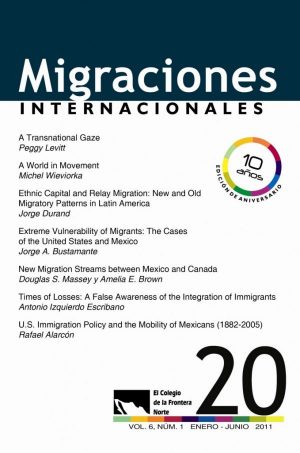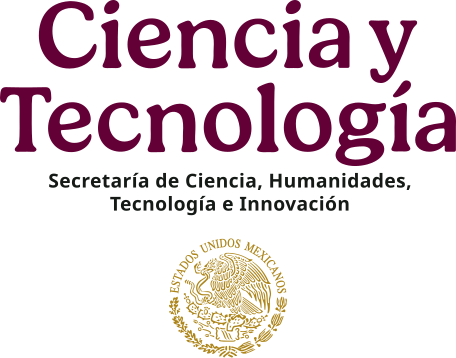U.S. Immigration Policy and the Mobility of Mexicans (1882-2005)
DOI:
https://doi.org/10.17428/rmi.v6i20.1064Keywords:
international migration, immigration policies, legislation, United States, Mexico. La política de inmigración de Estados Unidos y la movilidad de los mexicanos (1882-2005)Abstract
Mexicans constitute the largest immigrant group in the United States. This article reviews history to examine the impact of U.S. immigration policy on the development of migration patterns from Mexico between 1882 and 2005. Despite the large number of Mexicans who have been admitted as immigrants, for several decades U.S. immigration policy sought to construct the Mexican immigrant as a temporary worker; however, recent legislation has established a more permanent migration pattern, currently involving seven million undocumented persons. The burden of more than a hundred years of U.S. immigration policy should grant undocumented Mexican immigrants special access to legal permanent residency.
Resumen
Los mexicanos constituyen el grupo inmigrante más numeroso de Estados Unidos. En este artículo se revisa la historia para analizar el impacto que ha tenido la política de inmigración de Estados Unidos en la consolidación de patrones migratorios desde México entre 1882 y 2005. A pesar de la gran cantidad de mexicanos que han sido admitidos como inmigrantes, durante muchas décadas la política de inmigración de Estados Unidos buscó integrar al migrante mexicano como un trabajador temporal; sin embargo, legislaciones más recientes han instaurado un patrón de migración más permanente, en el que están involucradas siete millones de personas indocumentadas. El peso de más de cien años de política de inmigración de Estados Unidos debería garantizar el acceso especial a la residencia permanente legal a los inmigrantes indocumentados mexicanos.
References
Alanis Enciso, Fernando Saúl, 2004, “Nos vamos al norte: La emigración de San Luis Potosí a Estados Unidos entre 1920 y 1940”, Migraciones Internacionales 7, vol. 2, num. 4, JulyDe cember, pp. 66-94.
Alarcón, Rafael, 1995, Immigrants or Transnational Workers? The Settlement Process among Mexicans in Rural California, Davis, California, California Institute for Rural Studies.
Alarcón, Rafael, 2007, “The Free Circulation of Skilled Migrants in North America”, in Antoine Pécoud and Paul de Guchtenei re (eds.), Migration Without Borders. Essays on the Free Move- ment of People, Paris/Oxford/New York, unesco Publishing/ Berhahn Books.
Alarcón, Rafael, and Rick Mines, 2002, “El retorno de ‘los solos.’ Migrantes mexicanos en la agricultura de los Estados Unidos”, in María Eugenia Anguiano and Miguel Hernández (eds.). Mi- gración internacional e identidades cambiantes, Zamora, El Co legio de Michoacán/El Colegio de la Frontera Norte.
Bilateral Commission on the Future of United StatesMexican Relations, 1989, The Challenge of Interdependence: Mexico and the United States, Lanham/New York/London, University Press of America.
Bustamante Jorge, 1979, “Las mercancías migratorias. Indocu mentados y capitalismo: Un enfoque”, Nexos, num. 24, July.
Bustamante, Jorge, 1980, “Los problemas fronterizos”, in Barkin,et al. (eds.), Las relaciones Mexico/Estados Unidos, 1, Mexico, Universidad Nacional Autónoma de México/Nueva Imagen.
Bustamante, Jorge, 1983, Espaldas mojadas: Materia prima para la expansión del capital norteamericano, Mexico, D. F., El Colegio de México (Cuadernos del ces, 9).
Calavita, Kitty, 1992, Inside the State: The Bracero Program, Im- migration and the I.N.S, New York, Routledge.
Calavita, Kitty, 1994, “U.S. Immigration and Policy Responses: The Limits of Legislation”, in Wayne Cornelius, Philip Martin, and James Hollifield (eds.), Controlling Immigration. A Global Perspective, Stanford, Stanford University Press.
Cardoso, Lawrence A., 1980, Mexican Emigration to the United States 1897-1931. Socio-Economic Patterns, Tucson, Arizona, University of Arizona Press.
Cheng, Lucie, and Philip Q. Yang, 1998, “Global Interaction, Global Inequality and Migration of the Highly Trained to the United Sates”, International Migration Review, vol. 23, num. 3, pp. 626-653.
Cornelius, Wayne, 1990, “Impacts of the 1986 U.S. Immigration Law on Emigration from Rural Mexican Sending Communities”, in Frank Bean, Barry Edmonston, and Jeffrey Passel (eds.), Undocumented Migration to the United States. irca and the Experience of the 1980s, Lanham/London, rand Corporation/The Urban Institute.
Cornelius, Wayne, 1992, “From Sojourners to Settlers: The Changing Profile of Mexican Migration to the United States”, Jorge Bustamante, Raúl Hinojosa, and Clark Reynolds (eds.), U.S.-Mexico Relations: Labor Market Interdependence, Stanford, Stanford University Press.
Cornelius, Wayne, 2001, “Death at the Border: Efficacy and Unintended Consequences of U.S. Immigration Control Policy”, Population and Development Review, vol. 27, num. 4.
Craig, Richard B., 1971, The Bracero Program: Interest Groups and Foreign Policy, Austin, University of Texas Press.
Durand, Jorge, and Douglas Massey, 2003, Clandestinos. Mi- gración México-Estados Unidos en los albores del siglo xxi, Mexico, Universidad Autónoma de Zacatecas/Miguel Ángel Porrúa.
Escobar, Agustín, Frank Bean, and Sidney Weintraub, 1999, La dinámica de la emigración mexicana, Mexico, Centro de In vestigaciones y Estudios Superiores en Antropología Social/ Miguel Ángel Porrúa.
Galarza, Ernesto, 1964, Merchants of Labor. The Mexican Bracero Story, California, McNally & Loftin Publishers.
García y Griego, Larry Manuel, 1988, “The Bracero Policy Ex periment: U.S.Mexican Responses to Mexican Labor Migra tion, 19421955”, doctoral dissertation, Los Angeles, California, University of California, Department of History.
García y Griego, Manuel, 1996, “The Importation of Mexican Contract Laborers to the United States, 19421964”, in David Gutiérrez (ed.), Between Two Worlds: Mexican Immigrants in the United States, Wilmington, Delaware, Scholarly Resources.
Hall, Linda, 1982, “El refugio: Migración mexicana a los Estados Unidos, 19101920”, Históricas. Boletín del Instituto de Investi- gaciones Históricas, num. 8, México, D. F., Universidad Nacio nal Autónoma de México.
Heer, David, 1996, Immigration in America’s Future, Boulder, Colorado, Westview Press.
Hoffman, Abraham, 1974, Unwanted Mexican Americans in the Great Depression: Repatriation Pressures 1929-1939, Tucson, Arizona, The University of Arizona Press.
Hollifield, James, 2004, “The Emerging Migration State”, International Migration Review, vol. 38, num. 3, fall, pp. 885-912.
Jimenez, Maria, 2009, Humanitarian Crisis: Migrant Deaths at the U.S.-Mexico Border, American Civil Liberties Union of San Diego & Imperial Counties/Mexico’s National Commission of Human Rights.
Jones, Robert C., 2007, “Los braceros mexicanos en Estados Uni dos durante el período bélico. El programa estadounidense de prestación de mano de obra”, in Jorge Durand (comp.), Bra- ceros. Las miradas mexicana y estadounidense. Antología 1945- 1964, México, D. F., Senado de la República, Lx Legislatura/ Universidad Autónoma de Zacatecas/Miguel Ángel Porrúa.
Kiser, George and David Silverman, 1979, “Mexican Repatriation during the Great Depression”, in George C. Kiser and Mar tha Woody Kiser (eds.), Mexican Workers in the United States: Historical and Political Perspective, Albuquerque, New Mexico, University of New Mexico Press, pp. 45-66.
López Sala, Ana María, 2005, Inmigrantes y Estados: La respuesta política ante la cuestión migratoria, Barcelona, Anthropos.
Mármora, Lelio, 2002, “Políticas de migraciones internacionales”, Mexico, Paidós Mexicana/Organización Internacional para las Migraciones.
Martin, Philip L., 1990, “Harvest of Confusion: Immigration Reform and California Agriculture”, International Migration Review, vol. xxiv. num. 1, spring.
Massey Douglas, Jorge Durand and Nolan Malone, 2002, Beyond Smoke and Mirrors: Mexican Immigration in an Era of Economic Integration, New York, Russell Sage Foundation.
McWilliams, Carey, 1990, [1948], North From Mexico: The Spanish-Speaking People of the United States, New York, Praeger.
Mines, Richard and Ricardo Anzaldúa, 1982, New Migrants vs. Old Migrants: Alternative Labor Market Structures in the Cali- fornia Citrus Industry, San Diego, California, University of California, Center for U.S.Mexican Studies (Monographs in U.S.Mexican Studies, num. 9).
Morales, Patricia, 1982, Indocumentados mexicanos, México, Grijalbo.
Ochoa, Álvaro, 1988, “Arrieros, braceros y migrantes del oeste michoacano, 18491911”, in Thomas Calvo and Gustavo Ló pez (eds.), Movimientos de población en el occidente de México, Mexico, El Colegio de Michoacán/Centre D’Etudes Mexicai nes et Centramericaines.
Palerm, Juan Vicente, 1991, Farm Labor Needs and Farm Workers in California 1970 to 1989, Sacramento, California, California Employment Development Department.
Papademetriou, Demetrios, 1996, “U.S. Immigration Policy After the Cold War”, Pittsburgh, University of Pittsburgh Press.
Passel, Jeffrey, 2005, Estimates of the Size and Characteristics of the Undocumented Population, Washington, DC, Pew Hispanic Center.
Passel, Jeffrey and D’Vera Cohn, 2008, Trends in Unauthorized Immigration: Undocumented Inflow Now Trails Legal Inflow, Washington, DC, Pew Hispanic Center, October 2. Available at <http://pewhispanic.org/files/reports/94.pdf> (last accessed on October 4, 2010).
Pécoud, Antoine and Paul de Guchteneire, 2005, “Migraciones sin fronteras: Una investigación sobre la libre circulación de personas”, Migraciones Internacionales 9, vol. 3, num. 2, July December.
Plewa, Piotr and Mark J. Miller, 2005, “Postwar and Post Cold War Generations of European Temporary Foreign Worker Policies: Implications from Spain”, Migraciones Internacionales 9, vol 3, num. 2, JulyDecember, pp. 5883.
Portes, Alejandro and Ruben Rumbaut, 2006, Immigrant America. A Portrait, third ed., Berkeley, University of California Press.
Reisler, Mark, 1976, By the Sweat of Their Brow: Mexican Immigrant Labor in the United States 1900-1940, Westport, Connecticut, Greenwood Press.
Relaño Pastor, Eugenia, 2004, “Los continuos cambios en la po lítica de inmigración en España”, Migraciones Internacionales 6, vol 2, num. 3, January-June, pp. 110141.
Reyes, Belinda, Hans Johnson and Richard van Swearingen, 2002, Holding the Line? The Effect of Recent Border Build-Up on Unauthorized Immigration, San Francisco, California, Public Policy Institute of California.
Samora, Julian, 1971, Los Mojados: The Wetback Story, Notre Dame, University of Notre Dame.
Sassen, Saskia, 1988, The Mobility of Labor and Capital. A Study in International Investment and Labor Flow, Cambridge, Massachusetts, Cambridge University Press.
Schmidley, Dianne, 2001, Profile of the Foreign – Born Population in the United States: 2000, Washington, DC, U.S. Census Bureau/U.S. Government Printing Office (Current Population Reports, Series P23-206).
Smith, Rogers M., 2010, “Constitutional Democracies, Coercion and Obligations to Include”, in Jeffrey K. Tulis and Stephen Macedo (eds.), The Limits of Constitutional Democracy, Princeton, New Jersey, Princeton University Press.
Takaki, Ronald, 1993, A Different Mirror: A History of Multicultural America, Boston, Massachusetts, Little, Brown & Co.
Taylor, Paul S., 1933, A Spanish-Mexican Peasant Community: Arandas in Jalisco, Berkeley, University of California Press.
U.S. Congress, Congressional Budget Office, 2006, “Immigration Policy in the United States”, (A cbo Paper ).
U.S. Department of Homeland Security, 2004, Yearbook of Im- migration Statistics 2003, Washington, DC, U.S. Government Printing Office.
U.S. Immigration and Naturalization Service, 1992, Statistical Yearbook of the Immigration and Naturalization Service, 1991,Washington, DC, U.S. Government Printing Office.
U.S. Immigration and Naturalization Service, 2000, Statistical Yearbook of the Immigration and Naturalization Service, 1998,Washington, DC, U.S. Government Printing Office.
U.S. Immigration and Naturalization Service, 2001, Statistical Yearbook of the Immigration and Naturalization Service, 2000, Washington, DC, U.S. Government Printing Office.
United States Census Bureau, 2007, American Community Survey. Available at <http://www.census.gov/acs/www/> (last accessed on September 1, 2010).
Usdansky, Margaret and Thomas Espenshade, 2001, “The Evolution of U.S. Policy toward Employment Based Immigrants and Temporary Workers: The H1B Debate in Historical Perspec tive”, in Wayne A. Cornelius, Thomas J. Espenshade and Idean Salehyan (eds.), The International Migration of the Highly Skilled: Demand, Supply, and Development Consequences in Sending and Receiving Countries, San Diego, California, University of Cali fornia, Center for Comparative Immigration Studies.
Wasem, Ruth Ellen, 2004, “U.S. Immigration Policy on Perma nent Admissions”, crs Report for Congress, Congressional Re search Services, The Library of Congress , Washington, DC, February.
Weintraub, Sidney et al., 1998, “Responses to Migration Issues”, Estudio binacional México-Estados Unidos sobre migración, vol. 1, “Capítulos temáticos”, México, D. F./Washington, DC, Secretaría de Relaciones Exteriores/Commission on Immigration Reform
Woodrow, Karen A. and Jeffrey Passel, 1990, “Postirca Un documented Immigration to the United States: An Assessment Based on the June 1988 cps”, in Frank Bean, Barry Edmonston and Jeffrey Passel (eds.), Undocumented Migration to the United States. irca and the Experience of the 1980s, Lanham/London, rand Corporation/The Urban Institute.
Yale-Loehr, Stephen, 1991, Understanding the Immigration Act of 1990, Washington, DC, Federal Publications.
Zabin, Carol et al., 1993, A New Cycle of Poverty. Mixtec Migrants in California Agriculture, Davis, California, California Insti tute for Rural Studies.
Zolberg, Aristide, 2006, A Nation by Design: Immigration Policy in the Fashioning of America, Cambridge, Massachusetts, Har vard University Press.
Downloads
Published
Issue
Section
License
Authors publishing work in this journal agree to the following conditions:
Authors retain copyright and assign first publication rights to the journal Migraciones Internacionales (MI), with the texts registered under an Attribution-NonCommercial-NoDerivatives 4.0 International Creative Commons license (CC BY-NC-ND 4.0), which allows third parties to use published material provided they give credit to the authors and acknowledge this journal as the first publisher.
They authorize the reproduction, publication, translation, communication, and transmission of their paper and all accompanying material, publicly and in any form and by any means; its public distribution in as many copies as required; and public communication thereof in any form, including making it available to the public through electronic means or any other technology, and solely for dissemination and scientific, cultural, and non-commercial purposes.
Authors may enter into further independent contractual agreements for the non-exclusive distribution of the version of the paper published in this journal (for instance, to include it in an institutional repository or personal webpage, or publish it in a book), provided it is not for commercial purposes and they clearly state that the work was first published in Migraciones Internacionales (MI) [and add the corresponding bibliographical record: Author/s (Year). Title of paper. Migraciones Internacionales, volume (number), pp. doi: xxxx].
To that end, authors must submit the form assigning ownership of first publication rights, duly completed and signed. This document is to be uploaded in PDF format as a complementary file on the OJS platform.
This work is released under an Attribution-NonCommercial-NoDerivatives 4.0 International Creative Commons license (CC BY-NC-ND 4.0)..













